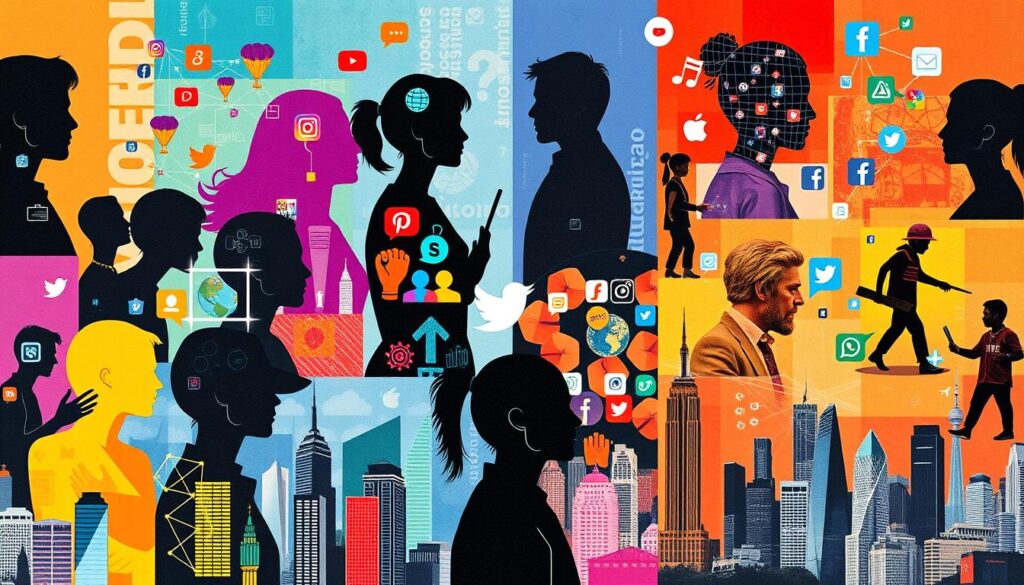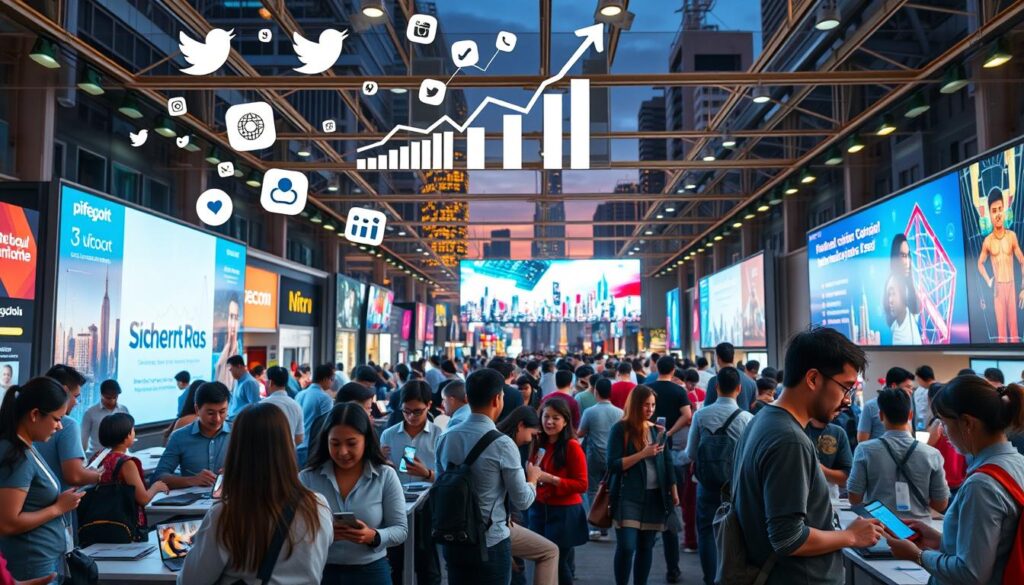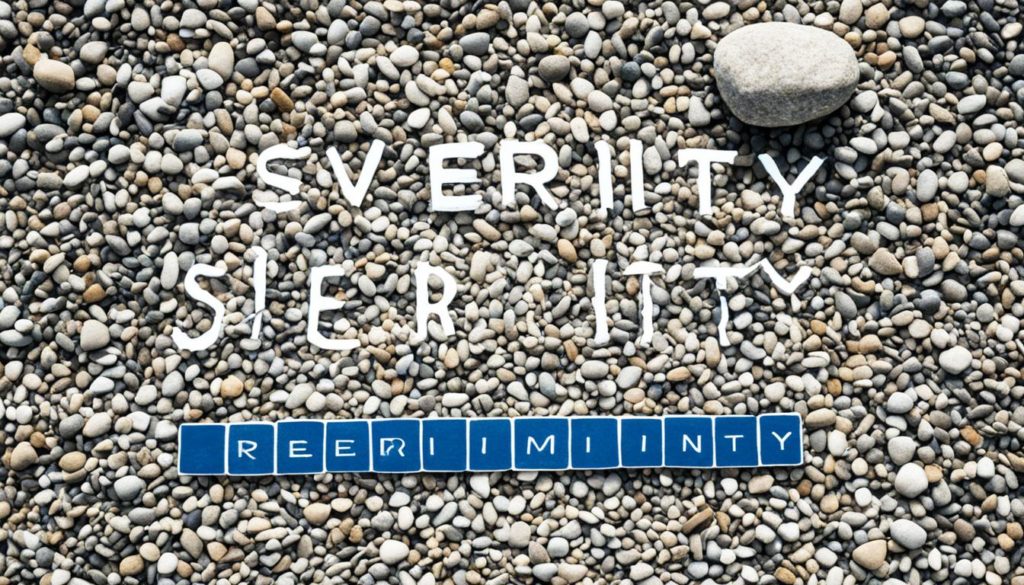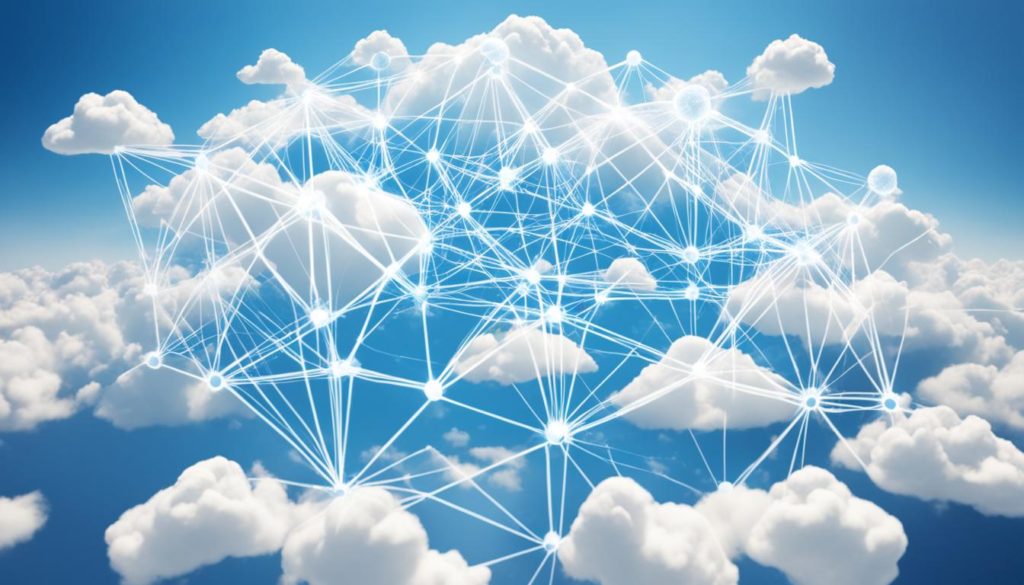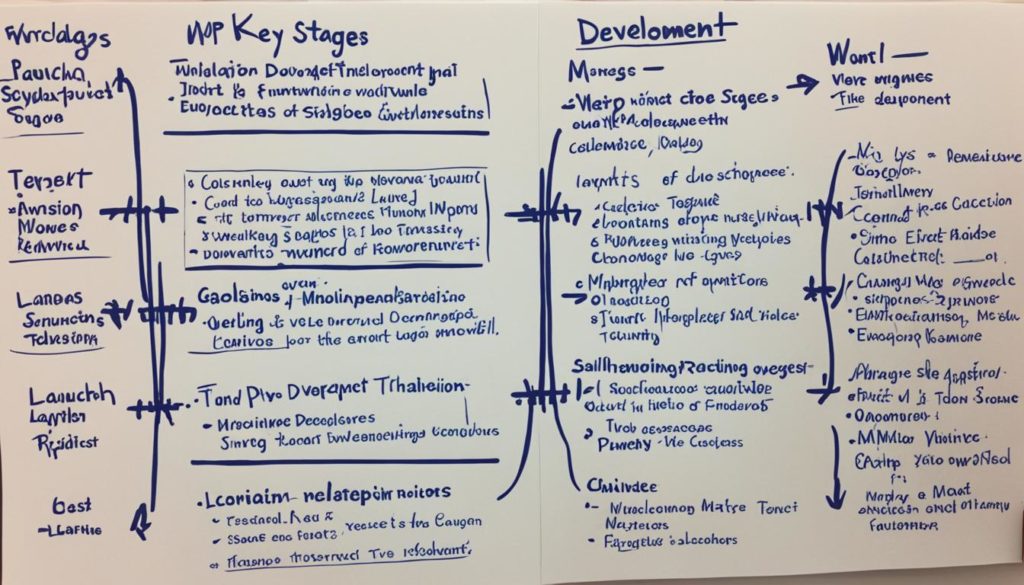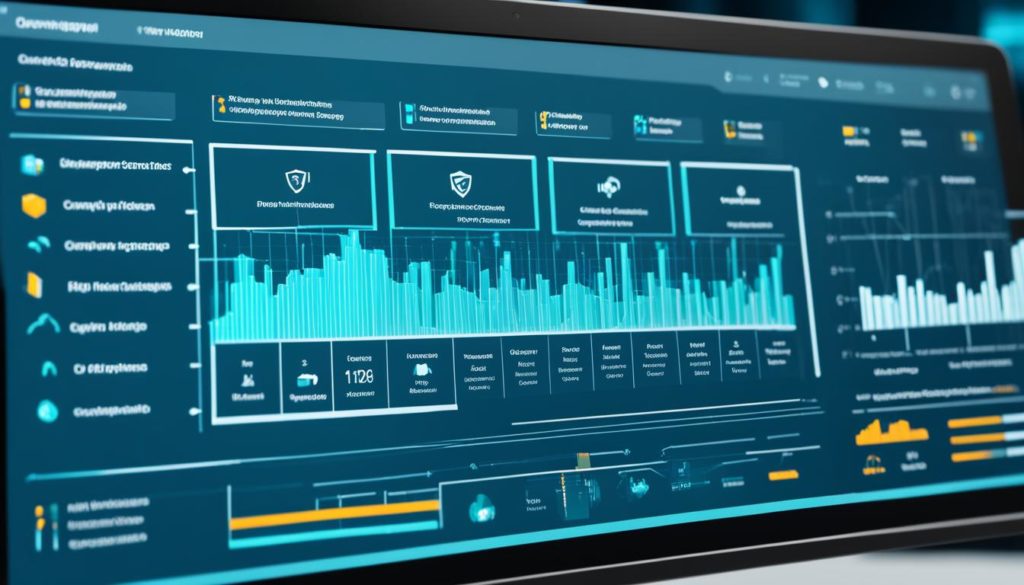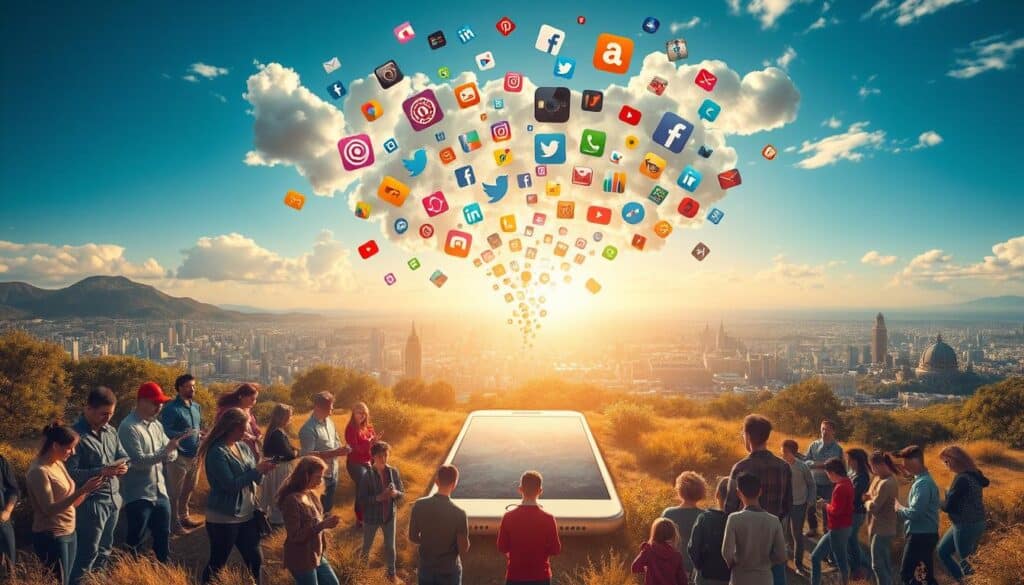
Did you know that 70% of young people compare themselves to social media images? This can lead to lower self-esteem and body positivity. Social media’s influence is vast, affecting our self-image and driving social change.
Platforms like Facebook, Twitter, Instagram, and TikTok have changed how we talk to each other. They impact our mental health, cultural trends, and business practices. Spending more than 2 hours a day on social media can make you 30% more likely to feel anxious or depressed.
Social media also helps start movements like #MeToo and fights for climate change. But it can spread false information and divide us. A survey found 62% of people have seen fake news online, which can change how we think about politics.
Social media affects more than just our personal lives. It’s also key in business, with Instagram and LinkedIn becoming important marketing tools. Influencer marketing has given businesses new ways to connect with their audience, making social media crucial for business success.
Key Takeaways
- 70% of young people compare themselves to social media images, negatively affecting self-esteem.
- Spending over 2 hours per day on social media increases the likelihood of experiencing anxiety and depression by 30%.
- Social media plays a crucial role in political activism and societal movements like #MeToo.
- 62% of people have encountered fake news on social media, impacting their political views.
- Platforms like Instagram and LinkedIn have become essential marketing tools for businesses.
Transformation of Communication Through Social Media
Social media has changed how we talk to each other, breaking down old barriers. It lets us connect in real time. This social media impact study shows how these platforms have changed our conversations worldwide.
Breaking Geographical Boundaries
Before, where you lived limited who you could talk to. But now, with Facebook, YouTube, and Twitter, we can reach anyone, anywhere. Even in places like China, Iran, and Turkmenistan, where some platforms are blocked, social media connects over 1.6 billion people.
Instant Communication and Real-Time Updates
Twitter, launched in 2006, changed how we share and get news. It’s all about quick, short updates. Now, we can follow global events and personal updates as they happen. A 2023 Pew Research Center study found that 30% of Americans aged 18 to 29 get news from TikTok, showing how fast news spreads.
Emergence of New Communication Norms
Social media has changed how we talk. Instagram, Snapchat, and Facebook Stories let us share our lives in real time. This new way of sharing mixes our public and private lives, making our online selves more open.
Emojis, GIFs, and viral trends now help us express feelings in messages. Businesses use these trends to connect with their fans, showing how social media changes how we talk to each other and to brands.
The quick sharing of news on social media shows how important real-time connectivity is today. Facebook and YouTube are key players in modern communication, showing their big role in our lives.
| Platform | Launch Year | Key Feature | Current Usage Statistics |
|---|---|---|---|
| 2004 | Connecting friends and family | Leading source for news for 30% of U.S. adults | |
| YouTube | 2005 | Video sharing and live streaming | Second most used for news by 26% of U.S. adults |
| 2006 | Real-time dialogue | Popular for breaking news and instant updates | |
| 2010 | Visual discovery | Enhances visual communication styles | |
| TikTok | 2016 | Short-form video content | Favored by younger demographics for news |
Cultural Trends and Identity Construction on Social Media
Social media is a powerful tool for shaping cultural trends and identities. Memes spread quickly, creating a shared experience that changes how we act and think. Instagram, Twitter, and TikTok are key places for building and showing our online identities.
This process is fast because of how connected we are online. We share information quickly, which changes how we see ourselves and the world.
Role of Memes and Viral Trends
Meme culture has changed how we talk and share ideas. Memes spread fast, becoming part of our everyday language. They bring people together, showing what’s popular in digital culture.
TikTok challenges and Instagram meme pages are big in setting these trends. They spread through different groups and even reach mainstream media.
Formation of Digital Identities
Our online identities are shaped by social media. Facebook and LinkedIn focus on professional achievements. Instagram and Snapchat are for sharing photos and videos.
People carefully choose what to share online. They show parts of themselves they might not in real life. This helps them understand and express their identity better.
Influencers also play a big role. They show different lifestyles and ideas. Their posts help us see and celebrate cultural diversity.
YouTube and Instagram are full of cultural expressions. They start global conversations that challenge and celebrate identity.
| Age Group | Social Media Use | Influence on Identity |
|---|---|---|
| 18-29 | Prolific Users in Developed Nations | High Impact |
| 30-49 | Frequent Users but Less Engaged | Moderate Impact |
| 50+ | Less Frequent Users | Low Impact |
The mix of social media trends and identity shows how online platforms change culture. As we keep using these platforms, it’s important to see how they affect us and our world.
Mental Health and Social Media
Social media has changed how we connect and talk to each other. It has both good and bad effects on our mental health. While it helps us stay connected and find support, too much screen time can harm our mental health.
Positive Impacts: Connectivity and Support
Social media is great for connecting and building support networks. It gives us a safe place to share and find people who think like us. For example, Facebook groups and Twitter threads help us share and get advice.
Being active online can make us feel less stressed and more connected. Instagram and Snapchat let us keep in touch with loved ones far away. This helps us feel like we belong.
Negative Impacts: Anxiety, Depression, and Isolation
But, social media also has downsides. A study by the University of Pennsylvania found that too much use can make us feel lonely. Seeing perfect lives online can make us anxious and depressed.
Also, about 10 percent of teens get bullied online, which hurts their self-esteem. This can lead to mental health problems.
Too much social media can make depression, anxiety, and stress worse. It can also harm our body image and lead to addiction. People who use it too much often feel sad and have low self-esteem.
Balancing Social Media Use for Mental Well-Being
To stay healthy, we need to balance our social media use. Spending time with people face-to-face is better for our mental health. Setting limits on screen time and avoiding it before bed helps.
Doing things offline and valuing in-person connections is key. Being careful about the quality of our online interactions can make our experience better. It’s important to find real connections and happiness beyond social media.
Our actions online and offline affect our mental health and well-being. It’s crucial to be mindful of how we use social media.
Impact of Social Media on Business and Marketing
Social media has changed how businesses market and connect with customers. Today, 94% of business leaders say social media data helps them make better decisions. This shows how vital social media is for building a brand and keeping customers loyal.
With data from social media, companies can make smart choices. These choices help them stay ahead and succeed in the future.
Social Media as a Marketing Tool
Social media lets businesses create marketing plans that really talk to their audience. Social media ads can increase sales, leads, and website visits if done right. Being quick to answer customer questions builds trust and loyalty.
The Rise of Influencer Marketing
Influencer marketing is big now. Almost half of consumers buy things because of influencer posts. This shows how much influence these endorsements have.
Working with influencers helps brands reach more people. It creates real connections that boost a brand’s online presence. Plus, 30% of people trust influencers more than they did six months ago.
Building Brand Loyalty Through Social Media
Keeping customers loyal on social media means staying in touch and being relevant. Almost 68% of consumers follow brands to learn about new stuff. This shows how important it is to post regularly and interestingly.
Talking to customers through comments and posts builds loyalty. It also creates brand fans. This interaction is key to keeping customers coming back, something 88% of leaders agree on.
| Aspect | Percentage |
|---|---|
| Impact on Top Priorities | 94% |
| Competitive Positioning | 92% |
| Future Success Dependency | 91% |
| Critical to Customer Retention | 88% |
| Expectation to Use More Data | 88% |
| Trust in Influencers | Nearly 50% |
The Menace of Misinformation
In today’s digital world, misinformation spreads fast. It’s a big problem we need to tackle. This includes false info on social media, whether it’s meant to deceive or not.
Spread and Impact of Fake News
The fake news impact is alarming. About 50% of young people see false content online every day. This can make them feel upset, sad, angry, or scared.
A 2021 study showed that misinformation hits young people hard. It shapes their opinions and actions. For instance, many teens think masks don’t work and kids can’t get COVID-19. This shows how fake news can deeply influence us.
The Role of Algorithms and Echo Chambers
Algorithms on social media push sensational content to keep users engaged. This creates echo chambers. Echo chambers make users more likely to believe false info.
Platforms like TikTok are battlegrounds for both misinformation and truth. This is especially true during big events like the Ukraine conflict.
Strategies to Combat Misinformation
To fight social media misinformation, we need many approaches. Teaching digital literacy and critical thinking is key. Programs like the Online Media Literacy Strategy help kids and teens spot false info.
Resources like ProjectEVOLVE give students tools to learn about misinformation. This raises awareness and helps them make informed choices.
Here’s a quick look at ways to fight misinformation:
| Strategy | Description | Examples |
|---|---|---|
| Digital Literacy | Teaching users to critically evaluate online content | Online Media Literacy Strategy |
| Educational Resources | Providing tools and curriculum to understand misinformation | ProjectEVOLVE |
| Platform Policies | Implementing restrictions to control misinformation spread | WhatsApp’s forwarding limits |
By using these strategies, we can build a society that’s informed and strong against misinformation.
Conclusion
Social media has a huge impact on society. People spend an average of 2 hours and 24 minutes daily on these platforms. It has changed how we communicate, affects our mental health, and changes business strategies.
The good side of social media is clear. It has made information more accessible, allowed for global interaction, and helped with political activism. Also, 52% of U.S. adults get their news from social media, showing its importance.
But, there’s also a bad side. Misinformation can spread easily, hurting public health and vaccination rates. It can also make people feel anxious, depressed, and lonely.
We need to use social media wisely. By managing our screen time and checking information, we can reduce its negative effects.
In conclusion, social media has a big impact on society. It can bring people together or drive them apart. We must use it responsibly.
Its positive effects are clear, but we must watch out for the downsides. As the digital world grows, so must our ways of using social media. This way, we can enjoy its benefits while avoiding its harms, making our society healthier and more informed.
FAQ
What is the impact of social media on our self-image and societal interactions?
Social media has changed how we see ourselves and others. It connects us and gives us a voice. But, it can also make us feel bad by making us compare ourselves to others.
How has social media transformed communication?
Social media has changed how we talk to each other. It lets us connect with people all over the world instantly. This has made our communication more immediate and connected.
What role do memes and viral trends play in social media culture?
Memes and trends are big in social media. They help us share experiences and shape what’s cool. They let us show who we are online, while staying true to ourselves.
What are the positive and negative impacts of social media on mental health?
Social media can be good for our mental health by connecting us. But, too much of it can make us anxious or lonely. It’s important to use it wisely and take breaks.
How do businesses utilize social media for marketing?
Companies use social media to talk directly to customers and market in a personal way. Influencer marketing makes ads feel more real. Regularly interacting with customers helps build brand loyalty.
What challenges does misinformation on social media present?
False information spreads fast on social media, creating echo chambers. This can sway public opinion and decisions. We need to be better at spotting fake news and think critically online.
How can we combat the spread of fake news and misinformation on social media?
To fight fake news, we need to get better at spotting it. We should think critically and verify information. Teaching people to be digitally savvy and informed is key.
Future App Studios is an award-winning software development & outsourcing company. Our team of experts is ready to craft the solution your company needs.


